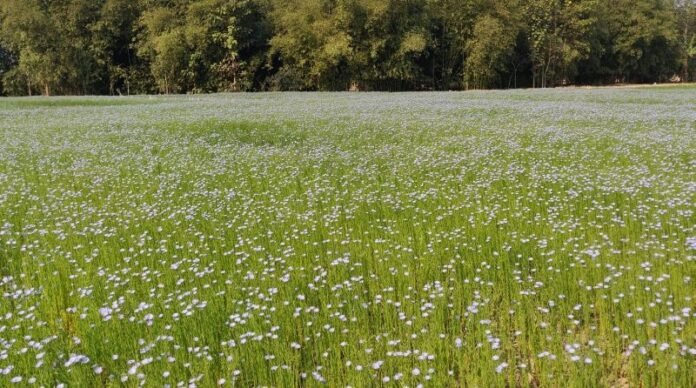Linseed cultivation is done on a large scale, and it is produced as a fibre crop. A good quantity of oil is found in linseed seeds, which is not used for food but is used to make medicines.
Linseed stems contain high-quality fibres, from which linen is also prepared. The byproduct obtained from oil extraction is given as food to the milk-yielding animals. Moreover, its oil has a special quality, due to which it dries up and hardens as soon as it is in contact with air. However, India ranks fourth in the world in terms of linseed cultivation.
Requirements For Linseed Cultivation
Suitable Soil & Climate For Linseed Cultivation
Black loamy soil with proper drainage is needed for linseed crops. The land with a normal pH value is suitable for its cultivation. Also, a cold and dry climate is considered ideal for linseed crops. In our country, linseed cultivation is done after rabi seasonal crops.
Normal rainfall is sufficient for its crop. Therefore we can easily do linseed cultivation in areas which have an annual rainfall of 40 to 50 cm. Its plants develop properly in normal temperatures, and a 15 to 20-degree temperature is required for the germination of seeds.
Field Preparation In Linseed Cultivation
For good the yield of Linseed, the field should be prepared adequately before planting its seeds in the area. For this, we should initially do deep ploughing of the field. After this, the field should be left open for some time. Then, around 10 carts of old cow dung manure should be put in the field on the basis per hectare.
Along with this, put one bag of N.P.K. in the field after ploughing in Linseed cultivation. Due to this, cow dung manure and chemical fertilizers will mix well in the soil. After mixing the soil in the field, apply water and plough it. After a few days of watering, when the field’s soil starts to look dry, use a rotavator operated by a Sonalika tractor for ploughing. Next, get the field ploughed by placing a plank, due to which the area will be levelled.
Planting Method And Season
The plants of Linseed are planted in the form of seeds. For this, seeds are sprinkled in the field, or a drill method is used. Moreover, the planting of linseed seeds is done in rows. Therefore, before planting its seeds, rows are prepared by keeping a distance of one foot in the field. It is necessary to have a distance of 5 to 7 CM between the seeds planted in the rows in Linseed cultivation.
If you want to transplant its seeds by spraying method, you should sprinkle the seeds in a flat field and do light ploughing using a cultivator operated by a Farmtrac tractor for efficiency. This will mix the seeds well in the soil of the field. 40 to 45 KG seeds are required for planting seeds by sprinkling method, while 25 to 30 KG are needed for planting by drill method.
Before sowing the linseed seeds in the field, remember that the seeds must be treated with a proper amount of Trichoderma Viride or Carbendazim. Due to this, their seeds are less prone to disease. Moreover, November in irrigated places and October for less water places is considered suitable for sowing linseed seeds.
Irrigation In Linseed Plants
Linseed cultivation does not require much irrigation. Its plants do not require more than two to three irrigations. Its initial irrigation is done about a month after seed planting, and the second irrigation is done during the flowering of the plants. Moreover, the third and last watering is done during seed formation.
Linseed Plant Weed Control
Linseed plants rarely require weed control. Natural methods of weeding and hoeings are used for weed control in its plants. Apart from this, weed control can also be achieved by using chemical methods. Furthermore, Pendimethalin 30 EC is highly recommended in the Linseed field. Moreover, a proper amount of spraying should be done after planting the seeds.
Harvesting And Yield
Linseed plants are ready to yield 120 days after seed transplanting. We should do it when the plants appear completely dry. It should be harvested near the root. After this, the seeds should be separated from the plants by shaking them. Its yield also differs depending on the variety of Linseed. Also, 15 quintal seeds can be obtained from its plants in a per hectare field, and 10 quintals per hectare yield is obtained in non-irrigated places. Up to 38% of linseed oil can be obtained from Linseed Cultivation, whose market value is very good.
Conclusion
In this way, we have explained the complete process of Linseed cultivation. In addition, we have covered the necessary steps for growing Linseed plants. Moreover, the large-scale production of Linseed can benefit the farmers by providing a higher income. Also, crop growers can boost the profits from Linseed cultivation by adopting modern farming machines, leading to increased efficiency.
For more information about the cultivation of profitable crops, stay connected with us.





